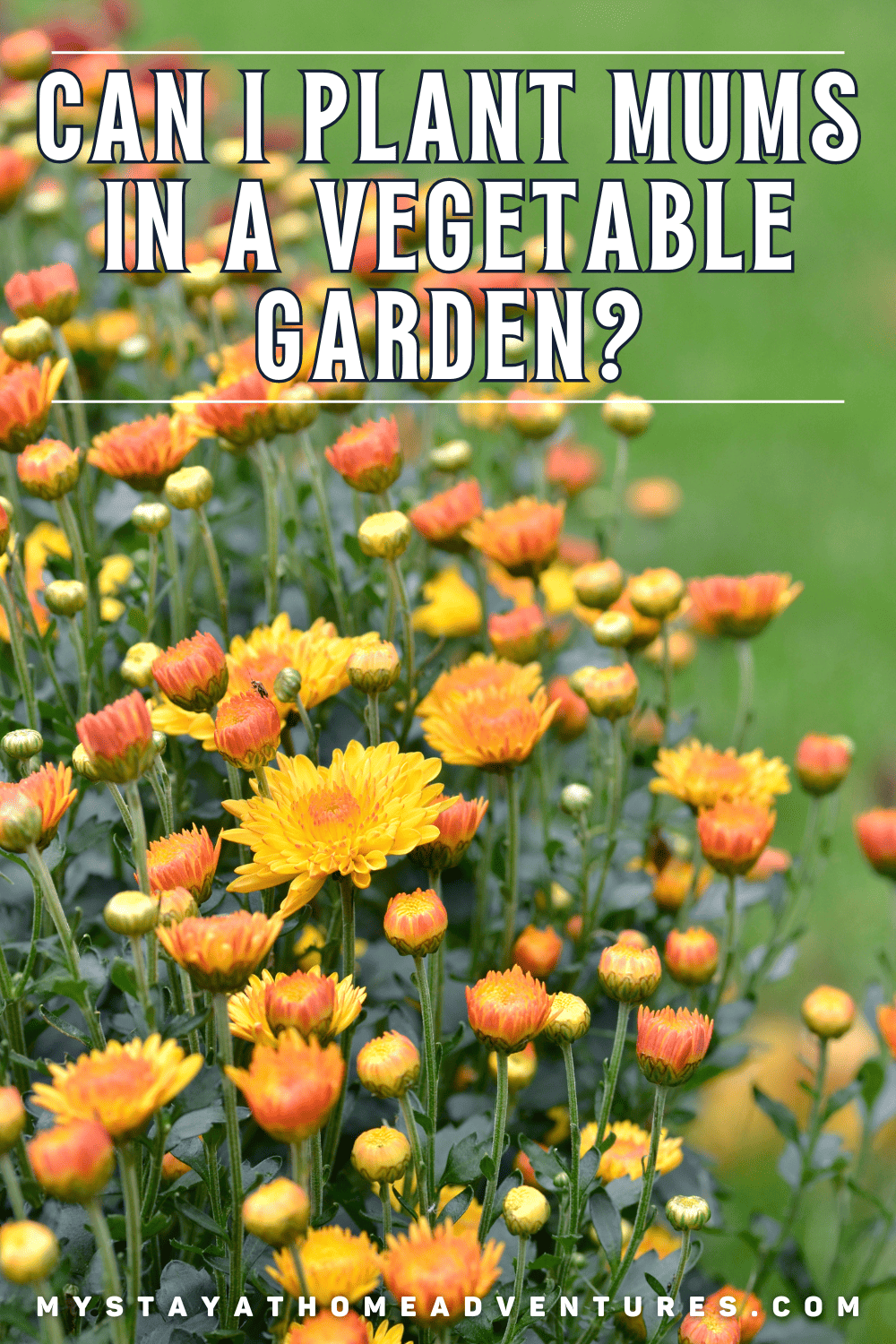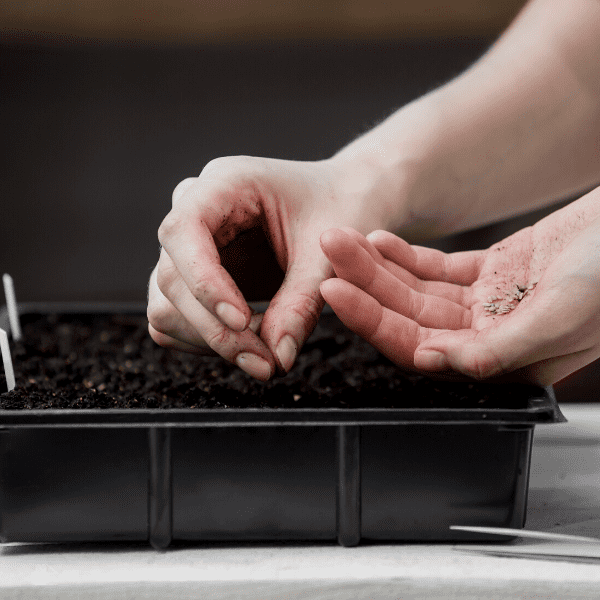Can I Plant Mums in a Vegetable Garden?
This post may contain affiliate links which might earn us money. Please read my Disclosure and Privacy policies hereMums are a favorite fall flower, but did you know they can also benefit your vegetable garden? Planting chrysanthemums alongside your vegetables can add beauty to your garden while helping with pest control. Learn how to incorporate mums into your garden and why they make great companion plants for a thriving fall garden.

Benefits of companion planting in vegetable gardens
Companion planting offers numerous advantages for your vegetable garden. By combining plants with complementary characteristics, gardeners can create a harmonious environment that promotes healthy growth and protects against pests. Some benefits of companion planting include:
- Pest control: Certain plants like marigolds or garlic have natural pest-repellent properties. By placing them near your vegetable plants, you can help deter pests and reduce the need for chemical pesticides.
- Increased pollination: Some companion plants, like members of the daisy family, attract beneficial insects that aid in pollination. This can lead to improved fruit sets and larger harvests in your vegetable garden.
- Improved nutrient uptake: Certain plant combinations can enhance nutrient uptake and soil health. For example, legumes like beans and peas have nitrogen-fixing capabilities, replenishing the soil with this essential nutrient.
Importance of choosing the right companion plants
When considering companion plants for your vegetable garden, choosing plants with compatible needs and growth habits is crucial. Mums, also known as chrysanthemums, may not be ideal for a vegetable garden due to their specific requirements. They prefer full sun, well-drained soil, and cooler temperatures. Vegetable plants often have different preferences, such as specific soil conditions or shade tolerance.
Instead, focus on selecting companion plants that have proven beneficial effects on vegetables. Examples include basil with tomatoes to enhance flavor and deter pests or nasturtiums near cucumbers to repel aphids. Choosing the right companions allows you to create a symbiotic relationship where both plants thrive together.
When planning your vegetable garden, choosing companion plants that have proven benefits for your desired vegetables is best. While mums may not be the most suitable option for a vegetable garden, plenty of other options can enhance the health and productivity of your crops.
Best Companion Plants for Mums in Vegetable Gardens
If you're a gardening enthusiast, you might be wondering if you can plant mums in your vegetable garden. The good news is that mums can indeed be a great addition to your vegetable beds. Not only can they add a pop of color to your garden, but they can also provide some benefits to your vegetable plants.
Marigolds: A perfect companion for mums in vegetable beds
Marigolds are often recommended as a companion plant for mums in vegetable gardens. These vibrant flowers are not only beautiful but also serve a practical purpose. Marigolds are known to repel many common garden pests, such as aphids, nematodes, and tomato hornworms. By planting marigolds alongside your mums, you can help protect your vegetable plants from these pests, reducing the need for harmful pesticides.
Nasturtiums: Enhancing the growth and health of mums in vegetable gardens
Another excellent companion plant for mums in vegetable gardens is nasturtiums. These edible flowers not only add a splash of color but also have several benefits for your garden. Nasturtiums act as a natural pest deterrent, attracting harmful insects away from your mums and vegetable plants. Additionally, they have properties that can improve soil health by repelling certain soil-borne pests and attracting beneficial insects. The leaves of nasturtiums can also be used in salads, adding a peppery and unique flavor.
You can create a visually appealing and functional garden by incorporating marigolds and nasturtiums into your vegetable garden alongside your mums. These companion plants add aesthetic value, help protect your vegetable plants, and improve overall soil health.

Creating a Healthy Garden with Mums and Vegetables
How mums provide shade and improve soil quality in vegetable gardens
Planting mums in your vegetable garden can offer various benefits to your plants and overall garden health. Mums are known for their vibrant colors and beautiful blooms. However, they can also provide shade to your vegetable plants, protecting them from harsh sunlight.
Creating a canopy of mums over your vegetable garden can regulate the temperature and prevent excessive heat stress on your crops. This shade can also help retain moisture in the soil, reducing the need for frequent watering. Additionally, mums have a deep root system that helps improve soil quality. Their roots break up compacted soil, allowing better water drainage and nutrient absorption for your vegetables.
The symbiotic relationship between mums and vegetables
Mums also have a symbiotic relationship with vegetables. Their flowers attract beneficial insects like bees and butterflies, which are essential for pollination. This, in turn, can enhance the yield and quality of your vegetable harvest. Moreover, mums release certain compounds that repel pests, acting as a natural pest deterrent for your vegetable plants.
When planting mums in your vegetable garden, it's important to consider their spacing. Ensure they are strategically placed to provide shade without overcrowding or overshadowing your vegetable plants. Additionally, choose mums that complement the overall aesthetic of your garden and consider their growth habits to prevent them from overpowering your vegetables.
Proper Planting Techniques for Mums in Vegetable Gardens
Garden lovers may find blending attractive flowers, such as mums, with useful vegetables enticing. However, is it feasible to grow mums in your vegetable garden? The answer is affirmative, yet a couple of factors must be considered.
Selecting the right location and soil conditions for mums
When planting mums in your vegetable garden, choosing a suitable location is crucial. Mums thrive in full sun, so make sure they will receive at least six hours of direct sunlight each day. Additionally, they prefer well-draining soil with a slightly acidic pH level. To improve its fertility and drainage, prepare the soil by incorporating organic matter like compost or peat moss.

Tips for planting mums alongside vegetables
- Spacing: Give your mums enough space to grow by keeping them at least 18-24 inches apart. This will prevent overcrowding and ensure proper airflow around the plants.
- Watering: Mums have shallow roots, so they require regular watering. However, be careful not to overwater, as this can lead to root rot. Aim for moist soil, but not soggy.
- Fertilizing: Mums benefit from regular feeding, especially during their growing season. Use a balanced slow-release fertilizer or a water-soluble fertilizer once a month to promote healthy growth.
- Planting time: Ideally, mums should be planted in the spring or early summer to allow them to establish themselves before the cooler temperatures of fall. Avoid planting them too late in the season, as they may not have enough time to develop strong root systems.
Overall, planting mums in your vegetable garden can add beauty and depth to your garden space. Just make sure to provide the proper location, soil conditions, and care to ensure their success alongside your veggies.
Can I Plant Mums in a Vegetable Garden?
If you're a beginner gardener who loves mums and wants to plant them in your vegetable garden, you should know a few things. While mums are beautiful and bring vibrant colors to your garden, they may not be the best companion for certain vegetable plants. Planting mums alongside certain vegetables can have detrimental effects on their growth. But don't worry! We have compiled a list of vegetable plants you should avoid planting next to mums, along with some alternatives that you can consider.
- Onions, Garlic, Leeks, and Shallots:
These pungent plants belong to the same Allium family, and unfortunately, they can stunt the growth of vegetables like pole beans and peas. Avoid planting them near mums if you want to ensure healthy growth for both. - Tomatoes:
Even though mums are often recommended to be planted near tomato plants as a natural pest deterrent, they can actually compete for nutrients and space. To avoid stunting the growth of either plant, it's best to keep them separate. - Cabbage Family Plants (Cabbage, Broccoli, Cauliflower, Kale, Brussels Sprouts):
Mums should not be planted near members of the cabbage family, as they can attract damaging insects and fungi that can harm the plants. It's best to keep these two plant families apart to maintain a thriving vegetable garden. - Pole Beans:
Just like their bush cousins, pole beans should not be planted near mums. Mums can inhibit the growth of pole beans, leading to a less fruitful harvest. - Peas:
Similar to beans, peas should also be kept away from mums. Mums can stunt the growth of peas, leading to weaker plants and decreased yields.
Now that you know which vegetable plants should not be planted next to mums, you might wonder what alternatives you can consider. Instead of mums, why not try planting marigolds? Marigolds are known for their strong scent, which helps to repel pests from your vegetable garden. Plus, they add a vibrant pop of color, just like mums!
Another great alternative is planting nasturtiums. Not only do they deter pests, but they also attract beneficial insects like bees and butterflies. Nasturtiums are beautiful and edible, making them a perfect addition to any vegetable garden.

Common Questions and Concerns
Can I plant mums in a vegetable garden?
If you have a vegetable garden and love mums, you might wonder if it's possible to plant both in the same area. The good news is that mums can be planted in vegetable gardens, but it's important to consider a few factors to ensure a balanced ecosystem.
Can mums compete with vegetables for nutrients?
One concern people have when planting mums in a vegetable garden is whether they will compete with the vegetables for nutrients. Mums are perennials that have deep root systems, so they do require nutrients from the soil. However, with proper planning, you can minimize the competition.
How to maintain a balanced ecosystem when planting mums in vegetable gardens
To maintain a balanced ecosystem when including mums in your vegetable garden, follow these tips:
- Choose the right variety: Select mums that are not too aggressive in spreading. Compact varieties are ideal as they require less space and resources.
- Space management: Plant the mums away from your vegetable plants. Provide a dedicated space for them so that they don't compete directly for nutrients.
- Soil enrichment: Ensure that the soil in your vegetable garden is rich in organic matter and nutrients. Regularly amend the soil with compost or well-rotted manure to provide adequate nutrition for both the vegetables and the mums.
- Proper watering: Water the plants thoroughly and evenly to avoid creating water imbalances or overwatering one species at the expense of the other.
By following these guidelines, you can create a harmonious environment where both your vegetable plants and mums can thrive. Remember to monitor the health of your plants regularly and make adjustments as needed to ensure everyone receives the proper care and nutrients.








